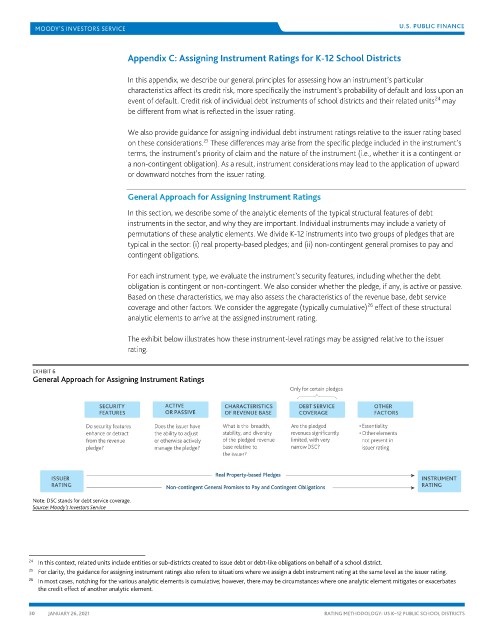Page 1668 - draft
P. 1668
U.S. PUBLIC FINANCE
Appendix C: Assigning Instrument Ratings for K-12 School Districts
In this appendix, we describe our general principles for assessing how an instrument’s particular
characteristics affect its credit risk, more specifically the instrument’s probability of default and loss upon an
event of default. Credit risk of individual debt instruments of school districts and their related units may
24
be different from what is reflected in the issuer rating.
We also provide guidance for assigning individual debt instrument ratings relative to the issuer rating based
25
on these considerations. These differences may arise from the specific pledge included in the instrument’s
terms, the instrument’s priority of claim and the nature of the instrument (i.e., whether it is a contingent or
a non-contingent obligation). As a result, instrument considerations may lead to the application of upward
or downward notches from the issuer rating.
General Approach for Assigning Instrument Ratings
In this section, we describe some of the analytic elements of the typical structural features of debt
instruments in the sector, and why they are important. Individual instruments may include a variety of
permutations of these analytic elements. We divide K-12 instruments into two groups of pledges that are
typical in the sector: (i) real property-based pledges; and (ii) non-contingent general promises to pay and
contingent obligations.
For each instrument type, we evaluate the instrument’s security features, including whether the debt
obligation is contingent or non-contingent. We also consider whether the pledge, if any, is active or passive.
Based on these characteristics, we may also assess the characteristics of the revenue base, debt service
26
coverage and other factors. We consider the aggregate (typically cumulative) effect of these structural
analytic elements to arrive at the assigned instrument rating.
The exhibit below illustrates how these instrument-level ratings may be assigned relative to the issuer
rating.
EXHIBIT 6
General Approach for Assigning Instrument Ratings
Note: DSC stands for debt service coverage.
Source: Moody’s Investors Service
24 In this context, related units include entities or sub-districts created to issue debt or debt-like obligations on behalf of a school district.
25 For clarity, the guidance for assigning instrument ratings also refers to situations where we assign a debt instrument rating at the same level as the issuer rating.
26 In most cases, notching for the various analytic elements is cumulative; however, there may be circumstances where one analytic element mitigates or exacerbates
the credit effect of another analytic element.
30 JANUARY 26, 2021 RATING METHODOLOGY: US K–12 PUBLIC SCHOOL DISTRICTS

